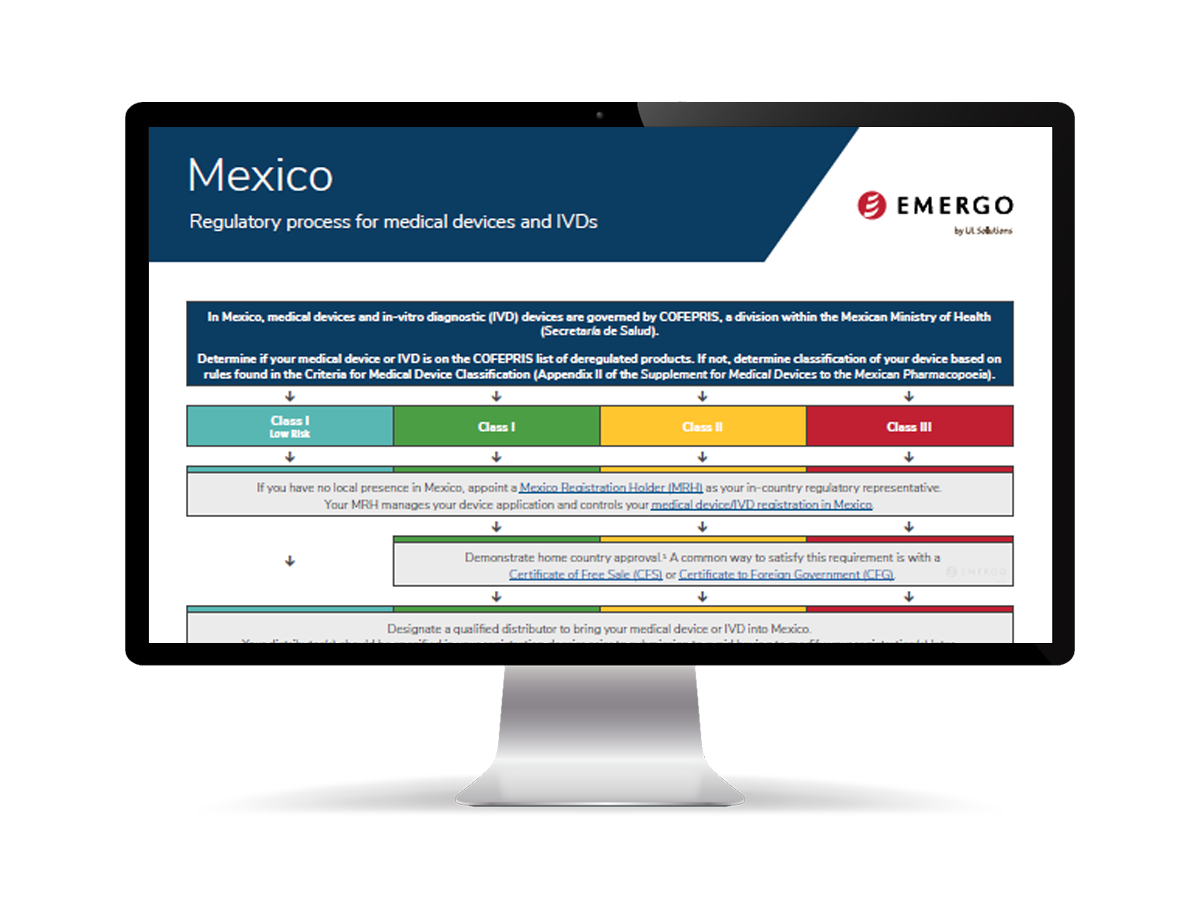주요 내용:
- 멕시코의 의료기기 분류 체계는 어떻게 되나요?
- 기기 그룹화는 등록 절차에 어떤 영향을 미치나요?
- 멕시코의 여러 의료기기 등록 경로는 어떻게 되나요?
멕시코는 라틴아메리카에서 브라질 다음으로 큰 의료기기 시장이며 의료기기 및 IVD 제조업체에 상당히 수익성이 뛰어난 시장이 될 수 있습니다. 그러나 멕시코에서 의료기기나 IVD를 등록하는 일은 시간이 오래 걸리고 까다로울 수 있습니다. 의료기기와 IVD의 감독을 담당하는 멕시코 보건부 소속 기관인 COFEPRIS는 온라인 등록 절차에 대해 제한된 정보를 제공합니다. 멕시코시티에 경험이 풍부한 컨설턴트 사무실을 두고 있는 Emergo by UL은 이 성장하는 시장에 진입하는 데 도움을 드릴 수 있습니다.
Emergo by UL의 COFEPRIS 의료기기 분류 및 그룹화 관련 지원 제공
멕시코에서 등록을 위한 첫 단계는 의료기기를 분류하는 것입니다. COFEPRIS 분류 규칙은 유럽 규칙을 적용했지만 멕시코 특유의 차이점이 몇 가지 있습니다.
의료기기는 위험도 증가에 따라 I 등급, II 등급, III 등급의 3단계 시스템으로 분류됩니다. 또한 COFEPRIS는 I 등급 저위험으로 간주하는 제품 목록도 제공하고 있는데 이는 여전히 규제를 받지만 검토 및 승인 시간이 더 빠릅니다.
제품군 그룹화는 필요한 등록 횟수에 영향을 미칠 수 있고 동일 기기의 다른 모델이나 버전을 등록할 때 유리할 수 있습니다. Emergo는 지침 참조와 기기 동등성 및 수백 건의 COFEPRIS 제출 그룹화 경험을 바탕으로 초기 분류 및 그룹화 결정을 내립니다.
멕시코 의료기기 승인 절차
COFEPRIS의 승인을 받을 때는 두 가지 옵션이 있습니다. Emergo by UL은 기기에 가장 효율적인 옵션을 추천하고 각 절차의 장단점을 설명해 드립니다. 당사의 의료기기 및 IVD 기기에 대한 멕시코 인허가 승인 절차 프로세스 차트에 COFEPRIS 승인 절차가 설명되어 있습니다.
동등성 검토 절차
미국, 캐나다 또는 일본에서 승인된 기기의 경우, 동등성 검토를 받을 자격이 될 수 있습니다. 동등성 검토에는 덜 상세한 기술 정보가 포함된 요약 서류 제출이 필요합니다. 캐나다 보건부 및 FDA 승인 기기에 대해서는 표준 검토보다 절차가 빠르며 서류 작업이 덜 필요합니다. 이 경로는 MHLW의 수출 인증서를 제공할 수 있는 일본 내 승인을 받은 제조업체에게도 마찬가지로 효율적입니다.
표준 검토 절차
Emergo는 전체 제품 기술 정보 및 해당 테스트 결과를 포함한 상세한 등록 서류 준비를 지원해 드릴 수 있습니다. 표준 검토 절차를 거치는 신청서도 유료로 제3자 검토를 받을 수 있습니다. 표준 경로 신청 타임라인은 동등성 타임라인보다 훨씬 더 길며 제3자 검토(Third Party Review)는 검토에 눈에 띄는 영향을 미치지 않습니다.
I 등급 저위험 기기는 기본적인 회사와 기기 정보가 있는 신청서를 COFEPRIS에 제출해야 하며, 정기적으로 COFEPRIS의 빠른 검토 및 승인 일정이 적용됩니다.
멕시코 내의 현지 지사가 없는 경우에는, 국내 대리인으로서 멕시코 등록 보유자(Mexico Registration Holder)를 지정해야 한다는 점에 유의하세요.
멕시코 COFEPRIS에 성공적인 의료기기 등록
Emergo by UL은 멕시코에서 승인을 받기 위해 수백 건의 기기를 제출했으며 직원 중에 풍부한 경험을 갖춘 이중 언어 규제 전문가가 있어서 가능한 가장 효율적인 방식으로 기기 승인을 받기 위해 필요한 것이 무엇인지 알고 있습니다. 당사가 수행하는 업무는 다음과 같습니다.
- 의료기기나 IVD의 분류 및 등록 경로를 결정합니다.
- 해당 시 등록을 위한 그룹화 전략을 결정하는 데 도움을 줍니다.
- 등록 경로에 필요한 서류를 파악합니다.
- 독립적인 멕시코 등록 보유자 역할을 수행합니다.
- 등록 신청 서류를 준비해서 COFEPRIS에 제출합니다.
- 제출 과정 중에 COFEPRIS 질문을 받아 처리합니다.
멕시코는 거의 전적으로 수입에 의존하는 성장세에 있는 라틴아메리카 지역 시장입니다. 따라서 제조업체에게 수익성이 높은 시장입니다. COFEPRIS의 승인을 받아 멕시코에서 판매를 시작할 수 있도록 도와드리겠습니다. 의료기기 등록 및 승인 컨설팅에 대한 자세한 정보가 필요하시면 당사에 문의하시기 바랍니다.
멕시코의 의료기기 등록, 규정 및 승인에 관한 자주 묻는 질문(FAQ)
멕시코에서 의료기기를 등록하는 데 얼마나 걸리나요?
승인 기간은 기기 등급과 제3자 검토 선택 여부에 따라 달라집니다. 자세한 일정과 비용은 의료기기 및 IVD 기기에 대한 멕시코 인허가 승인 절차 프로세스 차트를 참조하세요.
멕시코에서 등록하려면 ISO 13485가 필요한가요?
엄밀히 따지면 아닙니다. 하지만 멕시코에서 등록하려면 회사가 심사를 마친 품질 시스템임을 증명하는 자료를 제공해야 합니다. 대부분의 제조업체는 ISO 13485 인증서를 제공합니다. 그러나 정부 기관에서 발급한 품질 시스템 인증서를 제출해도 됩니다.
제3자 심사기관(TPR)은 무엇인가요?
제3자 심사기관은 의료기기 신청서를 '사전 승인(pre-approve)'할 수 있도록 COFEPRIS에서 지정한 독립적이고 공인된 영리 단체입니다. 이들은 멕시코 현지 회사이며 세계적으로 인정받는 등록기관/인증기관과 관련이 없습니다. 제3자 심사기관은 서류를 자세히 검토하며 사전 승인서를 발급하기 전에 종종 제조업체에 추가 정보를 요청하기도 합니다. 그런 다음 COFEPRIS에서 최종 검토를 완료하고 등록 인증서를 발급합니다. TPR을 이용하는 데는 추가 비용이 있으며, 요즘에는 검토 일정에 눈에 띄는 차이는 없습니다.
Emergo가 제3자 심사기관을 추천해 줄 수 있나요?
등록 보유자로 선택하시면 Emergo by UL이 귀사를 대신하여 TPR과 계약합니다. 이 프로세스의 일환으로 함께 일했던 기관에 대한 피드백 및 가격 정보를 제공하여 정보에 입각한 결정을 내릴 수 있도록 도와드립니다. 또한 프로세스 전반에 걸쳐 고객과 소통할 수 있도록 지원합니다.
등록 절차에서 제품군 그룹화는 얼마나 중요한가요?
제품군 그룹화는 완료해야 하는 등록 수에 영향을 미칩니다. 예를 들어, 유럽이나 미국에서는 하나의 등록으로 그룹화될 수 있는 기기가 일반적으로 멕시코에서는 여러 개의 등록이 필요합니다. 이 경우 등록 프로젝트에 소요되는 시간과 비용이 늘어납니다.
제품군 그룹화는 의도된 용도, 원재료(일반적으로 이식형 의료기기에 해당), 같은 그룹에 속한 제품 간의 상당한 기술적 차이와 같은 다양한 요인에 따라 달라집니다. Emergo는 시간과 예산을 최대한 활용하도록 그룹화 전략 정의에 도움을 줄 수 있는 경험을 보유하고 있습니다.
전문가에게 자세한 정보를 요청하세요
EMERGO 제품과 서비스에 관심을 가져 주셔서 감사합니다. 적합한 담당자를 연결해 드릴 수 있도록 정보를 입력해 주세요.









